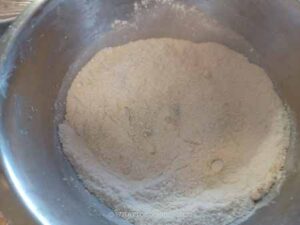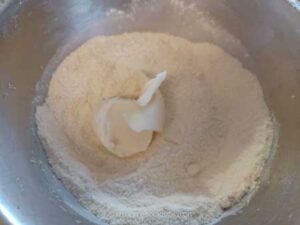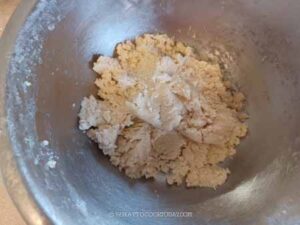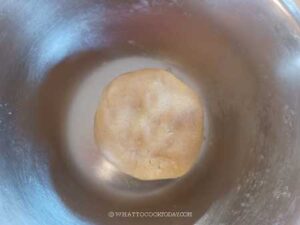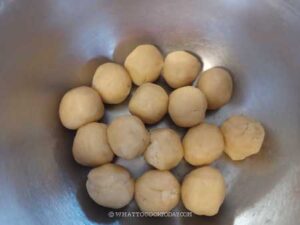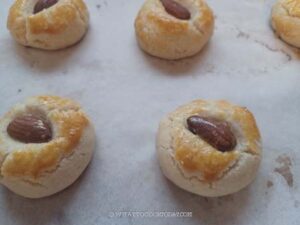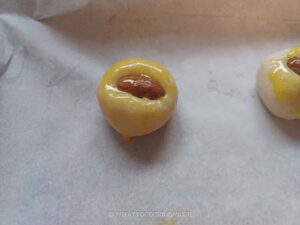This post may contain affiliate links. Please read our disclosure policy.
Learn how to make old-school Chinese almond cookies that are light, crunchy, sandy, and perfectly crumbly on the inside. This old-school recipe uses lard to achieve that texture!

Making old-school Chinese almond cookies with lard is a delicious way to honor tradition while satisfying that sweet tooth. The aroma alone will take you back to cherished memories of Chinese bakery visits or take-out nights. I remember as a kid seeing the individually wrapped almond cookie at bakery store and I always begged my dad to get some. It’s super messy to eat because of its crumbly texture, but yet it doesn’t stop me from eating them!
What Makes These Cookies Special
1. The Lard Factor: Lard sets these cookies apart, giving them a tender, crumbly texture that is difficult to achieve with other fats. It harks back to traditional Chinese baking, where lard was a common ingredient.
2. Textural Contrast: Crisp on the outside, these cookies melt into a sandy, crumbly bite—a hallmark of the perfect almond cookie.
3. Nostalgia in Every Bite: They transport you back to the classic Chinese restaurant experience, where almond cookies were often a sweet ending to a savory feast.
Old-School Chinese Almond Cookies (Using Lard)
Ingredients
Dry ingredients:
- 56 g almond flour
- 126 g granulated sugar
- 192 g all-purpose four
- ½ tsp baking soda
- ⅛ tsp baking powder
- ⅓ tsp fine sea salt
Other ingredients:
- 152 g lard or more as needed
- ½ tsp almond extract
Topping:
- 24 whole almond pieces
Egg yolk wash:
- 1 egg yolk
- 1 tsp water
Instructions
- Preheat the oven to 350 F (180 C). Line 2 large baking sheets with parchment paper. Position your oven racks, 3rd from the bottom and another one 3rd from the top
Prepare the dough (hands method):
- Whisk all the dry ingredients in a large mixing bowl.

- Add the lard and almond extract.

- Use your hands to rub the lard against the dry ingredients. It may seem like they are too dry at first, but just keep mixing

- It will form a dough

Prepare the dough (food processor method):
- Place all the dry ingredients in the bowl of a food processor. Pulse a few times to combine. Add the lard and almond extract. Pulse until the crumbly mixture starts to clump together. Do not overprocess. If you can press it together to form a dough, it's done
Shaping:
- Divide the dough into 24 equal pieces, about 22-25 grams each, about 1 1/2 Tbsp. Roll it into a round smooth ball.

- Place on a prepared baking sheet, about 2 inches apart. Press it one whole almond on top and flatten the cookie dough slightly with your palm while at it. Repeat with the rest of the dough and whole almond piece

- Brush the top with egg yolk wash

Baking:
- Place the baking pans on the positioned racks if you are baking two pans at the same time. Bake for 12 minutes and then rotate the pan front to back and top to bottom rack. Then continue baking for another 13 minutes or until the top is golden brown
- Let the cookies cool on the pan set on a cooling rack for 5 minutes. Then transfer cookies to a cooling rack to cool completely
- These cookies taste best after the next day. The flavor and texture gets better!
Storage:
- Once the cookies have cooled down completely, store them in an airtight container, in a cool dry place, for up to one week
- You can read more details on ingredients, substitutions, variations, and other tips in my post that may answer your questions not covered in the recipe card
*Nutrition facts are just estimates and calculated using online tools*
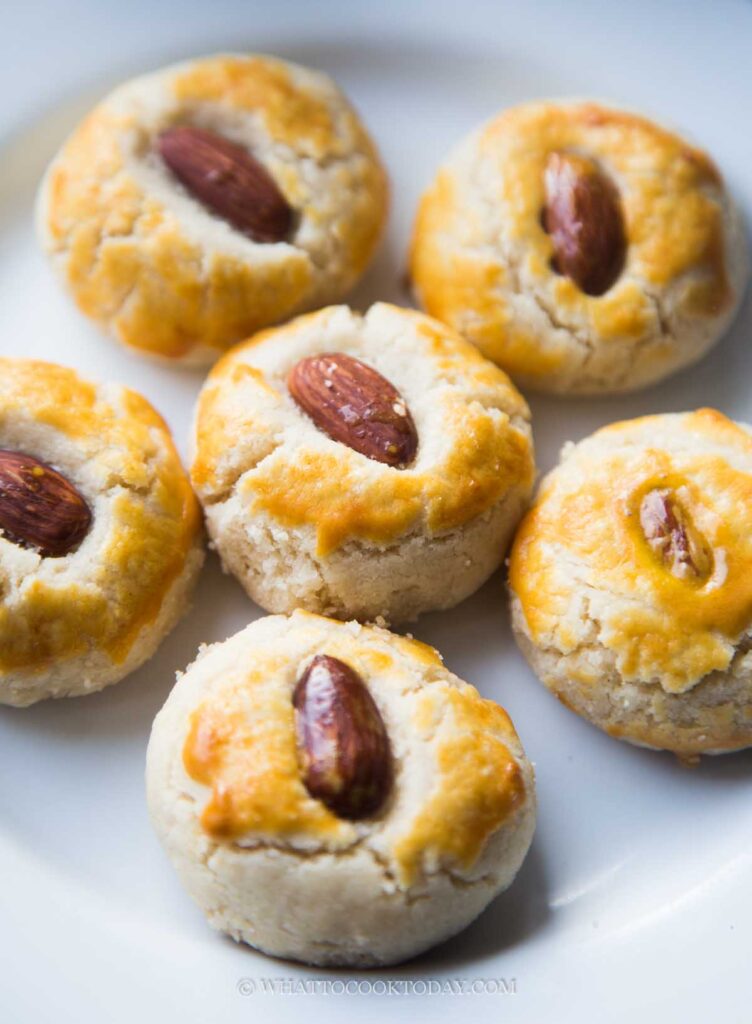
The Essential Ingredients
The hallmark of these cookies is their simplicity. Each ingredient serves a purpose, combining to create that light, yet indulgent texture:
1. Almond Flour: Adds a delicate nuttiness and enhances the sandy texture.
2. All-Purpose Flour: Provides structure and balance to the almond flour.
3. Granulated Sugar: Sweetens without overpowering, letting the almond flavor shine.
4. Baking Soda & Baking Powder: These leavening agents ensure a slight lift and a tender crumb.
5. Sea Salt: Enhances the flavors and balances the sweetness.
6. Lard: The secret to that signature crumbly texture. Lard makes these cookies wonderfully tender without being greasy.
7. Almond Extract: Intensifies the almond aroma and flavor
8. Egg Yolk Wash: Adds a beautiful sheen and golden hue to the finished cookies.
What type of lard to use
1. Leaf lard or homemade rendered lard
I recommend using leaf lard. It is more expensive, but it’s the cream of crop when it comes to lard. If you render your own lard using fat from around the pig’s kidney, that’s leaf lard. You can also use lard rendered from back fat. If you use homemade lard, you want to make sure they are white and doesn’t have a “piggy” smell. When you don’t render lard properly, the fat turns yellow because it was overcooked and fat starts to burn, lending that piggy smell. It’s fine for cooking, but not for pastires and cookies like this though.
2. Commercial lard
Commercially-prepared lard is convenient and it has neutral flavor but can have that artificial and waxy aftertaste. You can still use it for this recipe if that’s all you have access to. Choose the non-hydrogenated lard if possible.
What can I use to substitute for lard
I won’t substitute lard with other fat if you are looking for that crisp crumbly texture. These almond cookies have that incredibly light, crisp, and crumbly texture because of the lard. Lard has a unique crystalline structure that plays a crucial role in texture. When lard is mixed into dough, its crystals coat the flour particles more evenly than shortening or butter.
You can substitute with shortening, but it’s just not the same. Butter also will give you different result and texture. If you must replace, I would use shortening instead of butter. It comes closer to the texture using lard, but you will still notice the difference when compared side by side. Butter gives that cakier and not crumbly texture.
Tips for Success
1. Chill the Dough if necessary: If your kitchen is warm, refrigerating the dough for 15-20 minutes before shaping can make it easier to handle. Lard has lower melting point compared to when you use shortening and so it may feel greasy if your kitchen is too warm
2. Don’t Overbake: These cookies should be just golden on top and light at the edges. Overbaking can dry them out.
3. Storage: Keep the cookies in an airtight container to preserve their crispness and crumbly texture.

In the past, I’ve also made these almond cookies using oil, which is also one of our family’s favorite. It’s not as crumbly as this old-school Chinese almond cookies using lard, but they are good in their own way.

